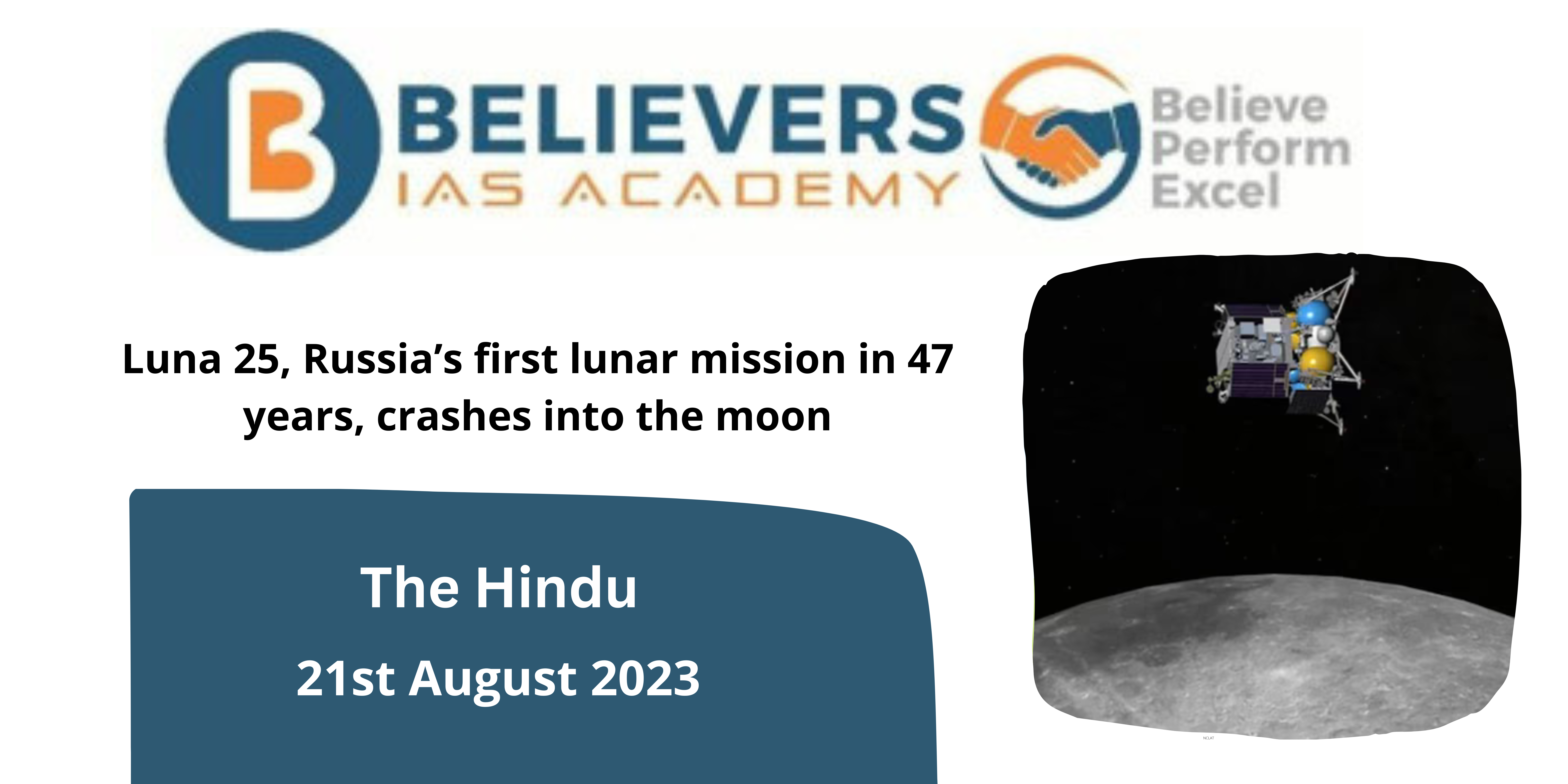Luna 25, Russia’s first lunar mission in 47 years, crashes into the moon
Context
Russia’s Roscosmos space agency said on August 20 that the Luna 25 spacecraft had collided with the moon after spinning out of control.
What is Luna 25?
- Roscosmos, the Russian space agency, is in charge of the lunar lander mission known as Luna 25, formerly known as Luna-Glob.
- The mission is a component of the larger Luna-Glob lunar exploration program, whose objective is to thoroughly investigate the Moon’s surface and environment.
What were the objectives of Luna 25?
- The main goal of Luna 25 is to touch down on the Moon’s surface, more precisely at the Boguslawsky crater, close to the lunar south pole.
- The mission’s objectives include carrying out scientific research, examining the lunar surface and exosphere, and gathering information about the lunar environment.
What do we know about Lunar 25 crash?
- On August 20, the Russian Luna 25 spacecraft slammed with the moon.
- The spacecraft’s uncontrollable entry into orbit and subsequent collision with the moon’s surface caused the accident.
- The spacecraft was unmanned and was headed for a landing near the south pole of the moon.
- Due to potential frozen water and precious element reserves, the south pole region is of interest.
- After experiencing issues, Luna 25 lost touch with Roscosmos (Russia’s space agency) on August 19.
- The project marked a significant comeback to lunar exploration as it was Russia’s first lunar effort since 1976.
What is the significance of Moons south pole?
- Water Ice Deposits: The discovery of water ice in the permanently shadowed areas of polar craters is one of the main reasons for researching the lunar south pole. Due to the geography and axial tilt of the Moon, these places receive relatively little sunlight, which enables them to store flammable substances like water ice. Water is necessary for human travel in the future and for potential lunar habitats since it can be utilized to produce oxygen, provide drinking water, and serve as a source of hydrogen and oxygen for rocket fuel.
- Scientific Exploration: The lunar poles offer distinctive prospects for scientific research. Since these substances can preserve details about the circumstances and ingredients present during the Moon’s origin, the presence of water ice and other volatile substances can provide light on the evolution of the solar system. The severe and diverse settings near the poles also provide an opportunity to research the lunar geology and thermal processes.
- Long-Term Sunlight: Areas of the Moon’s poles that get constant sunlight are referred to as “peaks of eternal light.” The Moon’s very minor axial tilt causes these areas to receive nearly constant sunlight. This makes them possible sites for solar power generation, which may be necessary to support operations on the lunar surface and upcoming human settlements.
- Accessibility: For robotic and prospective future crewed missions, the polar regions can also offer simpler access to both lunar far side communication (since they can provide line-of-sight to Earth) and some locations of the solar system.
When was the Last successful Russian programme done?
- In comparison to prior successes, the status of Russia’s space program has declined.
- When it came to launching artificial satellites and placing people in orbit, the Soviet Union (now Russia) was a pioneer.
- The Luna 25 disaster highlights the difficulties and dangers involved with space exploration.
Which other countries were able to succeed in this mission?
- The Soviet Union, the United States, and China are the only three nations to have accomplished successful moon landings.
- China’s Chang’e missions have been notably successful in recent lunar exploration
What is the status of Chandraayan Mission?
- The Chandrayaan 3 mission from India was launched on July 14 with the intention of landing near the south pole of the moon.
- On August 23, the powered descent of the mission’s lander is anticipated to start.
- Chandrayaan 3 is focused on studying the scientifically significant lunar south pole region, similar to Luna 25.
Conclusion:
- The failure of Luna 25’s mission highlights the complexities of space exploration and the risks involved.
- The moon’s south pole remains a region of great scientific interest for potential water and resource exploration.
- Despite setbacks, the quest for space exploration continues, with countries working towards unlocking the mysteries of the cosmos.




